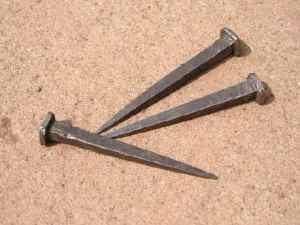
It is all very well presenting the historical evidence of Jesus’ Resurrection, as I did here. But if Jesus wasn’t actually dead before he was laid in that well known tomb…the conclusion is completely invalid. If Jesus of Nazareth survived his crucifixion, then there could be no miraculous resurrection…cos he wasn’t dead to begin with!
So I need to ask – is there any way of working out whether or not Jesus actually died as a result of his documented crucifixion by Roman Soldiers outside Jerusalem during the reign of Roman Emperor Tiberius?
Alex Metherell, M.D., Ph.D. is a forensic pathologist, a medical detective who has performed countless autopsies. He has a medical degree from the University of Miami and a doctorate in engineering from the University of Bristol. He has written for publications ranging from Aerospace Medicine to Scientific American.
Alex is also a Christian and, because he is a pathologist, he has studied the historical, archaeological and medical data concerning the death of Jesus of Nazareth.
Alex Metherell has studied the available data and he believes there is no possibility that Jesus of Nazareth survived the agonising experience of crucifixion. Jesus was dead when he was laid in that well known tomb.
A rather graphic summary (apologies!) of Alex’s evidence is listed below:
Psychological Stress as Jesus Anticipated the Cross
The Gospels record that Jesus prayed all night in the garden of Gethsemane where he began to sweat blood.
Hematidrosis is a recognised condition where capillary blood vessels that feed the sweat glands rupture, and sweat comes out of the skin tinged with blood.

Roman Flogging of Jesus
The solider would use a whip of braided leather thongs with metal balls and pieces of sharp bone woven in. The whip would strike the flesh on the back, buttocks and back of the legs repeatedly…39 lashes was common. What effect did this have?
- The balls would cause deep bruises that would burst open on repeated blows
- The skin on the back would become shredded, sometimes exposing the victim’s spine. One physician and expert on Roman beatings says the underlying skeletal muscles would be torn into producing quivering ribbons of bleeding flesh
- “The sufferer’s veins were laid bare, and the very muscles, sinews, and bowels of the victim were open to exposure.” Roman Historian Eusebius
- If the victim survived this flogging they would often go into hypovolemic shock. In other words, the effects of losing a large volume of blood. This means a drop in blood pressure, heart racing to pump blood that’s not there, extreme thirst as the body craves fluids to replace lost blood volume.
Approach to the Crucifixion Site
Jesus was forced to carry the horizontal beam of the cross all the way.
He struggled, and a Roman Soldier ordered a bystander (Simon) to help him
He was thirsty as he made the journey, which points to the effects of hypovolemic shock
Jesus was clearly in a critical condition before the nails were driven thru his hands and feet.
The Excruciating Agony of Crucifixion
The word excruciating was invented to describe the unique experience of crucifixion – the word literally means “out of the cross”.
Some people were tied to the cross, but the account of Jesus points to him being nailed to the cross. This was not uncommon; archaeologists have found remains buried in Jerusalem with a spike still attached to the bones of the foot with wood from the upright beam still present.
- Romans used spikes 5 to 7 inches long, tapered to a sharp point
- The spikes were driven thru the wrists (considered part of the hand in the language of the day) to attach him to the crossbar
- The crushing of the median nerves would be incredibly painful
- Once hoisted, the crossbar was attached to the vertical stake and spikes were driven thru his feet to attach him there
The physiological effects on his body would have been brutal.
- Both shoulders would dislocate (which fulfils the Old Testament prophecy in Psalm 22)
- Once in this agonizing position, crucifixion is a slow death by asphyxiation. The stresses on the body put it into the inhale position. In order to exhale air from the lungs, the victim has to push themselves up on his feet. Doing so would cause further tearing of the flesh in his feet. This process of dropping down again and pushing up to breathe would have been incredibly painful, and would have scraped his shredded back against the wooden upright
- Eventually exhaustion would cause the victim to cease pushing upwards and therefore cease breathing
- A lack of oxygen leads to respiratory acidosis – carbon dioxide in the bloodstream – leading to an irregular heartbeat. Combined with the hypovolemic shock, Jesus would most probably have died of heart failure.
Ensuring Jesus was Dead
The Roman soldiers who executed their victims were by no means experts on human anatomy; but they were skilled and experienced at executions. They knew how to kill people efficiently.
Often to speed up the process of crucifixion, they would use their metal spears to break the leg bones of the victim so that they could no longer push up to breathe – causing death very quickly.
In Jesus case, it is recorded that the Roman executioner was certain he was already dead. But he stuck his spear into his right side, probably between his ribs, to be sure.
- John’s Gospel records that blood and water ran out of this wound
- Assuming that the spear penetrated thru the lung into the heart, the pericardial effusion surrounding the heart, which was caused by the hypovolemic shock, would have burst giving the appearance of water running from the spear wound
Could Jesus have survived his crucifixion? Doctor Metherell’s conclusion is – not a chance.

BUT – say he did? Imagine that having experienced all that has been described, that he is revived in the cool of his tomb, rolls the stone away, evades the Roman Guards posted there, staggers away on feet that have been crushed by metal spikes. How would he have looked? The trauma would have left in in a pitiful state. His followers would not have seen him as the Lord of life who had triumphed over the grave. They would not have called him Lord…they would have called him a Doctor!
“…it’s preposterous to think that if he had appeared to them in that awful state, his followers would have been prompted to start a worldwide movement based on the hope that someday they too would have a resurrection body like this. There’s just no way.”
Was Jesus dead when he was laid in the tomb? A reasonable examination of the evidence suggests – yes, of course he was.
Adapted from:
Strobel Lee. The Case for Christ. Chapter 11 The Medical Evidence. Zondervan.

